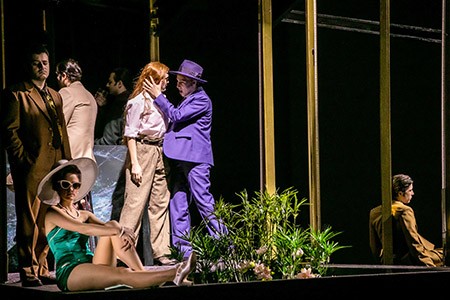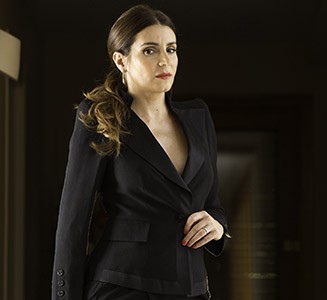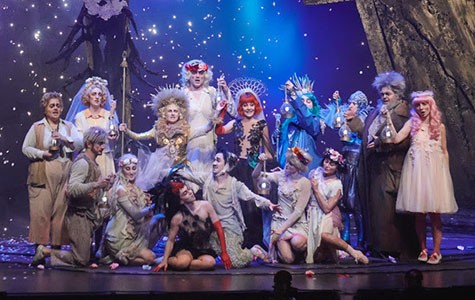
Se ofrecerán diez funciones de la ópera con dos repartos distintos entre los días 27 de octubre y 10 de noviembre.
Alcina es una coproducción del Teatro Real y de la Opéra National de Bordeaux, que estrenó la producción en 2012.
En su versión escénica, el director David Alden homenajea al teatro como refugio y evasión de la realidad, inspirándose en la película La rosa púrpura de El Cairo (1985), de Woody Allen.
Dos selectos repartos de siete cantantes se encargan de la interpretación de la ópera, incluyendo sus partes corales, bajo la experta batuta del británico Christopher Moulds al frente de la Orquesta Titular del Teatro Real.
En torno a Alcina se ofrecerá el próximo 5 de noviembre un recital del contratenor Xavier Sabata con arias de Händel compuestas para castrato, que tendrá lugar en el Auditorio Sony de la Fundación Albéniz (Plaza de Oriente).
Los programas del concierto de los Domingos de cámara del 8 de noviembre y del taller infantil ¡Todos a la Gayarre! del 15 de noviembre estarán también inspirados por la gran figura de Händel.
Hasta el día 17 de enero, la Biblioteca Nacional ofrece una exposición sobre las principales ediciones de Orlando furioso, de Ludovico Ariosto, poema épico del que parte el libreto de Alcina.
La función del día 10 de noviembre será retransmitida en directo en Palco Digital.
Entre los días 27 de octubre y 10 de noviembre el Teatro Real ofrecerá diez funciones de Alcina, de Georg Friedrich Händel (1685-1759), nueva coproducción del Teatro Real y la Opéra National de Bordeaux, donde la producción se estrenó en mayo de 2012.
Entre las 42 óperas que compuso Händel, Alcina —estrenada en 1735 en el Covent Garden de Londres en su última etapa como compositor operístico— está considerada como una de las más logradas en la caracterización de los personajes y en la expresión de sus emociones. Su dramaturgia moderna, sus inspiradas melodías y su brillante orquestación justifican la creciente presencia de esta obra en la programación de teatros y festivales de todo el mundo desde su ‘redescubrimiento’ en los años 60 del pasado siglo, después de más de doscientos años de olvido.
En Alcina, Händel recurre por tercera vez al poema épico Orlando furioso, de Ludovico Ariosto (1474-1533) —después de hacerlo en Orlando y Ariodante—, para retratar las emociones y las pasiones humanas con la libertad que le otorga el mundo alegórico, fantástico y sobrenatural del poeta italiano.
En su concepción escénica de esta ópera, el meticuloso director de escena estadounidense David Alden —que ha dirigido ocho títulos de Händel, incluyendo dos producciones diferentes de Alcina—hace un homenaje al cine y al teatro como espacios de evasión de la realidad.
Inspirándose en la película de Woody Allen La rosa púrpura de El Cairo, Alden transforma la isla encantada de Alcina en un pequeño teatro, adonde Ruggiero se escapa para huir de la rutinaria vida con su amada Bradamante. Ahí goza de los placeres eróticos y el embrujo de la impetuosa y pérfida hechicera Alcina, que da rienda suelta a sus deseos sexuales, desechando a sus sucesivos amantes y transformándolos en piedras y animales salvajes.
La trama se complica cuando Alcina sucumbe al amor verdadero por Ruggiero, mientras éste es finalmente rescatado por su amada Bradamante y los guardianes del orden y de la moral. Pero su liberación de las garras de la maga representa también la vuelta a la vida real, donde le perseguirá para siempre la nostalgia de ese mundo de ensueño, lujuria y desenfreno.
En Alcina siete personajes expresan una enorme y riquísima paleta de emociones a lo largo de más de tres horas de música, incluyendo 26 arias, partes corales (interpretadas por los siete solistas) y orquestales, en una mordaz y conmovedora epopeya lírica, que será interpretada en el Real por dos selectos repartos y la Orquesta Titular del Teatro Real, bajo la dirección del prestigioso director inglés Christopher Moulds.
La partitura, inscrita en los cánones de la llamada opera seria barroca, alterna los recitativos que avanzan la acción y las arias que expresan las emociones de los personajes y que dan alas a la exhibición virtuosística de los cantantes.
En el Real el reparto incluye dos papeles travestidos: Ruggiero —el joven prometido de Bradamante que enamora a la insaciable hechicera Alcina— fue escrito para un castrato y será interpretado por las mezzosopranos Christine Rice y Josè Maria Lo Monaco; Oberto —personaje juvenil y pizpireto que Händel creó para un virtuoso niño soprano que había llamado su atención en una representación de su ópera Ariodante— será encarnado por las sopranos Erika Escribá y Francesca Lombardi Mazzulli.
Karina Gauvin, intérprete del rol titular, ha sido una de las musas del director y musicólogo Alan Curtis, recientemente fallecido, con el que actuó y grabó asiduamente durante los últimos diez años. Con él y su conjunto, Il complesso barroco, se dio a conocer en el Real con Tolomeo, del mismo Händel, junto a la contralto Sonia Prina, otra gran especialista en el barroco, que la acompaña en esta ocasión como intérprete del papel de Bradamante (en el Real debutó en la temporada 2007-2008, junto a Les Arts Florissants, en L’orfeo de Monteverdi). El trío protagonista se completa con la mezzosoprano Christine Rice, que actuó en dos producciones dirigidas por Pier Luigi Pizzi en el Real: A Midsummer Night’s Dream, de Benjamin Britten e Il ritorno d’Ulisse in patria, de Claudio Monteverdi.
Estas tres cantantes se alternarán con Sofia Soloviy —Poppea e Nerone, Alceste y Le nozze di Figaro— en el papel titular, y con las mezzosopranos Josè Maria Lo Monaco y Angélique Noldus, que debutan en el Teatro Real.
Completan ambos repartos las sopranos Anna Christy y María José Moreno, como Morgana, y Erika Escribà y Francesca Lombardi Mazzulli, como Oberto.
Los papeles masculinos serán interpretados por los tenores Allan Clayton y Anthony Gregory, como Oronte, y el bajo Luca Tittoto y el barítono Johannes Weisser, como Melisso.
‘ALCINA’
ACTIVIDADES PARALELAS
Exposición ‘El Furioso en la BNE’
http://www.bne.es/es/Actividades/Exposiciones/Exposiciones/exposiciones2015/el-furioso/index.html?pagina=0
Selección de las principales ediciones de Orlando furioso, de Ludovico Ariosto
6 de octubre de 2015 – 17 de enero de 2016
Museo de la Biblioteca Nacional de España. Sala mínima
Enfoques
Encuentro con los directores y protagonistas de Alcina
22 de octubre, a las 20.15 h.
Teatro Real. Sala Gayarre
Entrada por la calle Felipe V
Acceso libre hasta completar aforo
Recital del contratenor Xavier Sabata
Markello Chrysikopoulos, clave
Simos Papanas, violón
5 de noviembre de 2015. 20.00 horas
Fundación Albéniz. Auditorio Sony
Plaza de Oriente. Entrada por calle Requena, 1
Los domingos de cámara
Alrededor de Georg Friedrich Händel
http://www.osm.es/es/Programacion/Detalle_Actividad.aspx?id=596&tipo=Conciertos&type=concierto
Programa
Parte I
Georg Friedrich Händel/Johan Halvorsen: Passacaglia para violín y viola
Georg Friedrich Händel: Sonata en trío para dos oboes, fagot y clave, HWV 381
Franz Joseph Haydn: Trío en Re mayor para flauta, viola y contrabajo
François Couperin: Las Naciones: La española
Parte II
Hugo Wolf: Serenata italiana, para cuarteto de cuerda
Ludwig van Beethoven: Cuarteto para cuerda op. 59 nº 3, “Razumovski”
Solistas de la Orquesta Titular del Teatro Real
8 de noviembre, a las 12.00 h.
Teatro Real. Sala principal
¡Todos a la Gayarre!
Alcina, la hechicera
Es muy bella, pero, cuidado, te puede convertir en cucaracha…
Taller concebido y presentado por Fernando Palacios
15 de noviembre, a las 12.00 y a las 17.00 h.
Teatro Real. Sala Gayarre
Entrada por la calle Felipe V





















